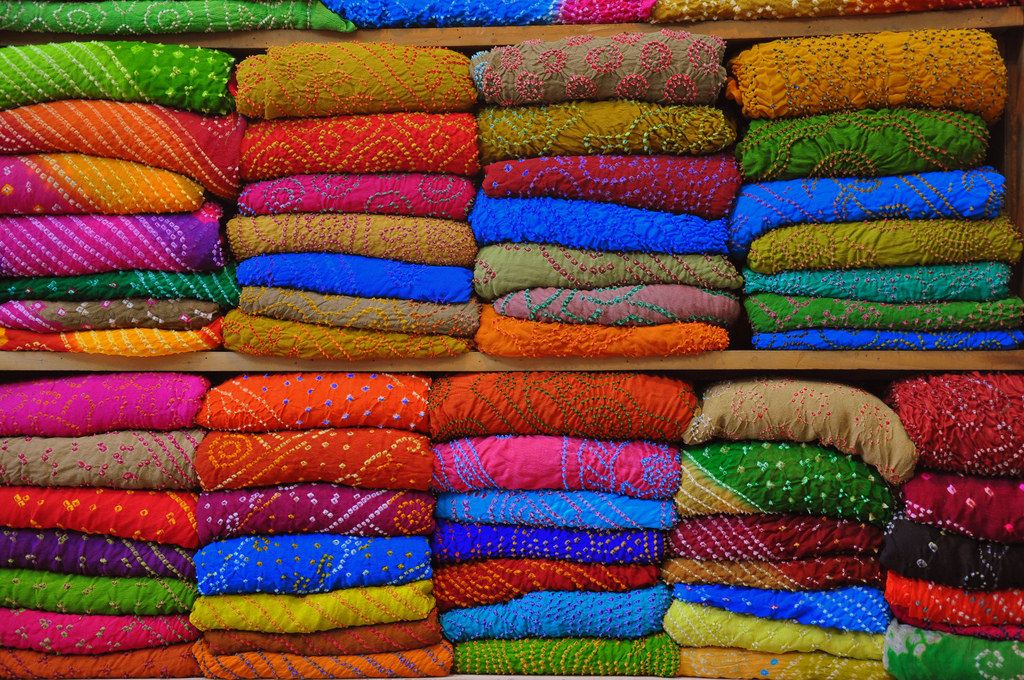
You might also like:
INDIA is a shopper’s paradise. The country produces an astonishing variety of traditional and modern goods at prices that are as compelling as the merchandise. But like everything in India, shopping can be a complex process. This series is intended to help you learn how to shop, as well as what to buy and where.
Colorful saris on sale. Pic: Bharat Singh/flickr
Textiles
India is famous for its textiles. Items vary from elaborately embroidered pashmina shawls to silk saris; from cotton kurtahs (long, tunic-style shirts), bedspreads, and pillowcases to appliqué wall hangings. You might do well bringing very little clothing to India and buying some kurtahs (men) and salwar kameez “suits” (women) from a chain store, like Fabindia or Anokhi. Wearing your souvenirs cuts down on excess baggage and you will fit in better, too. Be careful when buying pashminas: most shawls are wool and pashmina blends. Pure pashmina is very costly, and should be bought only from a trusted source. Buying silk saris is a fun activity; as you travel, find out what the popular sari style is in the region and buy what you can afford. Silk saris are a specialty of many regions, such as Varanasi, Mysore and Kanchipuram in Tamil Nadu. Cotton saris are a specialty in some places too, such as the Kota doria saris of southern Rajasthan (where Kota is).

Beautiful vessels sold in abundance. Pic: Sakshi Kumar/flickr
Art and handicrafts
This is another category that encompasses a mind-boggling array of goods. Indians have been fine artists, craftsmen and artisans since the dawn of time, and all over India you will see an explosion of creativity. Wood and stone carving, miniature painting, brass and copperware, leather work, enamel, rugs and carpets, antique (and made-to-look antique) furniture – the list goes on and on. If you are buying an investment piece you should know what you’re doing or buy from a trusted source. There are, unfortunately, a lot of scams. But for the average tourist, it’s fun to visit a local artist like Soni Gopal of Mayur Art who has a shop in the Bundi bazaar, and pick up a few paintings; or to spend an afternoon among the stone carvers of Mahabalipuram, looking for the perfect representation of Saraswati, goddess of the arts and knowledge.

An array of bangles for sale. Pic: Sam Hawley/flickr
Jewelry
Indian jewelry is in a class by itself. You just cannot compare. It tends to be big, bold, intricate and colourful. And like everything else in India, it changes from region to region. Jaipur, Rajasthan is the gem capital of India, but you can see the products of this industry in Delhi, Mumbai and even Hollywood. In Jaipur, the specialties are kundan (precious stones set in gold) and meenakari, enamel work in Mughal-inspired colours such as red, green and white. (There are jewelers in Jaipur whose ancestors made jewelry for the Muhgal emperors.) If buying semi-precious or precious stones, again, it is wise to either know what you are doing or buy from a reputable source. Gold is of course the favoured metal – the Indian love affair with gold is well-known. Typically, jewelry in India is made from 22 carat gold (a brighter yellow than western gold jewelry) and sold by weight. There are many traditional styles available – gold bangles are a classic choice.

A shop selling spices in Delhi. Pic: Wikimedia Commons
Spices, perfume and incense
For centuries, traders have been arriving in India by ship and camel caravan to load up on spices like black pepper, cardamom, turmeric and coriander. Today, you can visit spice markets in places like Old Delhi or the historic port of Cochin in Kerala and see it piled high in colourful mounds. Personally, I prefer to buy spices packed in plastic bottles by Roopak’s, a well-known brand. Along with single spices, Roopak’s makes dozens of blended spices that are fun to try. Note: a mixture of spices in India is not called curry, it is called masala; curry is a specific leaf. India also has a long history as a maker of attars (natural perfume oil derived from botanical sources) and incense, known in India as agarbathi. Attars were traditionally given as gifts to guests, in tiny, ornate, crystal decanters – and they still make good gifts today. Incense is available in many scents, such as the world-famous Nag Champa.

A shop selling tea leaves in Delhi. Pic: Wikimedia Commons
Tea
While the camellia sinensis (tea) plant is native to India, the tea industry started in earnest when British soldiers of fortune brought plants from China in the late 18th century and experimented with growing them in the northeast. Today, India is one of the world’s leading producers – and drinkers! – of tea, and many consider Darjeeling to be the “champagne of teas,” the finest in the world. You don’t have to travel to Darjeeling to buy tea, but why not? It’s a great place to visit: you can tour some of the tea gardens and the view of the Himalayas is divine. Other tea centers in India are Assam, Munnar in Kerala and the Nilgiri Hills in Tamil Nadu.
Source: travelwireasia.com
